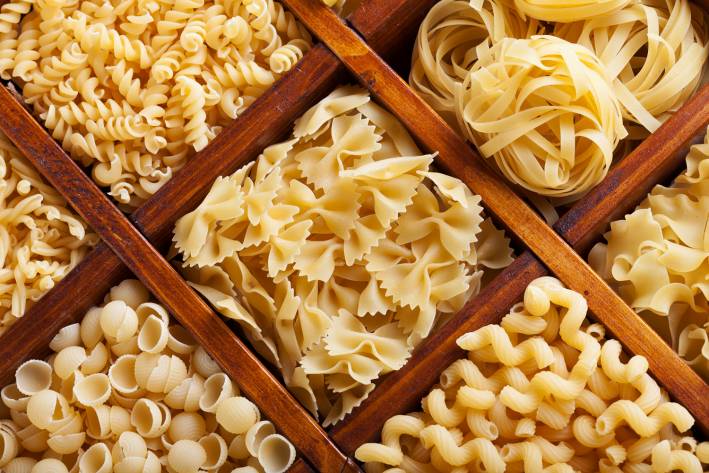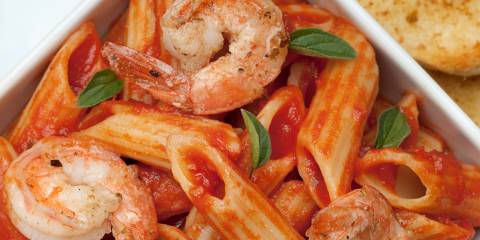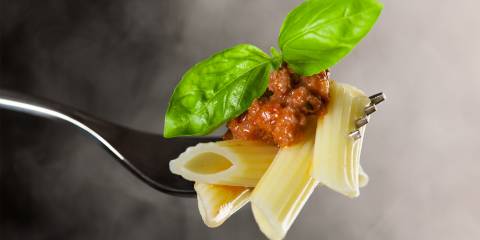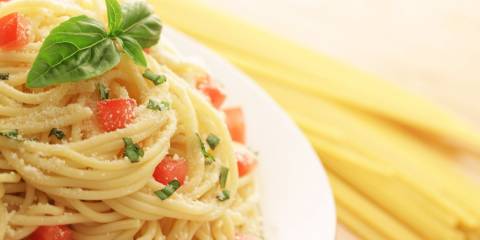Pasta can be found in an extraordinary number of varieties and shapes. A comprehensive list would be encyclopedic in length.
The same shape of pasta can have a different name depending on the region it is from. Sometimes the same name can even be used for a number of different shapes, depending on where you are.
When I first visited Verona to create a cooking school in its wine country, I was taken aback when I ordered lasagna at a restaurant and was served what to me were tagliatelle, noodles that are slightly wider than fettuccine (which by the way are called lasagnette in Verona).
The dish of baked lasagna that the rest of Italy is familiar with is called pasticcio in Verona.
Filled pastas shapes can be even more confusing. In Bologna, tortelloni are the large version of tortellini, the bishop’s hat-shaped pasta, which in Romagna are instead called cappelletti.
Different Shapes of Pasta
Listed below are the shapes you are most likely to encounter in Italy. They are divided into two main categories: flour-and-water pastas, and egg pastas.
-
Flour-and-Water Pasta Shapes
-
Spaghetti
Probably the best known of all pasta shapes, spaghetti's sturdy texture makes it a perfect vehicle for a wide variety of sauces, but not usually meat sauces or ones with large chunks.
-
Spaghettini
Literally, the little or thin spaghetti. It’s important to use a premium brand of spaghettini and not to overcook. It goes well with simple, savory sauces, but not heavy sauces.
-
Linguine
Linguine means “little tongues." They are used mostly in the southern part of Italy. They go well with sturdier pasta when a bit more surface area for sauce is desired.
-
Bucatini
Also called perciatelli by some manufacturers, these hollow spaghetti are wonderful with the robust sauces found in south-central Italy.
-
Fusilli
This fun shape can be either long, resembling a coiled telephone cord, or short like a corkscrew.
-
Penne
Penne are probably the most commonly used of the tubular pastas. They are available either smooth or ridged and in a variety of sizes. Penne go well with tomato sauces, sauces that have small chunks, and some heavier cheese sauces.
-
Machheroni
Maccheroni (macaroni) refers to a straight-edge tubular pasta, which like penne can be either smooth or ridged. Many sauces that are good with penne are also good with maccheroni.
-
Rigatoni
These large, wonderfully chewy and satisfying tubes are a classic popular shape in Italy. They are traditionally served with meat sauces, but are also good with chunky vegetable sauces.
-
Cavatappi
Their name means “corkscrews”, but unlike fusilli, they are hollow inside, somewhat like an enlarged section of the long fusilli. Their twisted shape wraps itself around chunky vegetable sauces wonderfully, and they are also great in certain hearty soups.
-
Orecchiette
These are a specialty of Apulia, where they are usually served with a broccoli rabe sauce; the name means “little ears”. They are traditionally made by hand from a flour-and-water pasta dough pressed between the thumb and palm.
-
Farfalle
Farfalle in Italian means “butterflies.” Their shape is excellent for meat sauces and chunky vegetable sauces.
-
Conchiglie
The name means “shells” and conchiglie are available in a variety of different sizes. The smallest ones are usually used in soups, the larger ones for sauces. One of my favorite parings is with butter and cheese because there is so much surface area for the sauce to coat.
-
Ruote
Also called ruote di carro, which means “cartwheels”, this pasta shape pairs well with chunky vegetable sauces, meat sauces, and sauces that are good with rigatoni.
-
Lumache
Lumache is Italian for “snails,” and they are similar to the curled shape of a snail’s shell. Meat sauces go especially well with this pasta.
-
Strozzapreti
The name, which literally means “priest stranglers,” supposedly came about after a priest’s gluttony led to a fatal encounter with this pasta. They are, of course, quite harmless and are traditionally made by hand from flour-and-water pasta dough in the south or from egg pasta in Romagna. They are about 1 1/2 inches long and resemble a piece of stretched telephone cord.
-
-
Egg Pasta Shapes
-
Fettuccine
This is probably the best known of the ribbon pastas. It is narrower that tagliatelle and best suited to delicate cream-based sauces. Its most famous pairing is probably the Roman Alfredo Sauce.
-
Tagliatelle
Bologna is the home of tagliatelle, flat noodles slightly wider than fettuccine. In 1972 the Accademia della Cucina Italiana, an organization devoted to preserving authentic Italian cuisine, created a replica of the “ideal” tagliatella in gold. Its most classic match is with Bolognese meat sauce.
-
Pappardelle
These are wide ribbons that in Bologna are also known as larghissime, which means “very wide.” They are good with most sauces for tagliatelle and where you want lots of surface area to be coated with the sauce.
-
Capelli D'Angelo
The name means “angel hair” because capelli d’angelo are extremely thin. They are traditionally served in a soup of homemade meat broth. In Italy they are never seved with sauce because they are too light and delicate.
-
Tagliolini
Except for capelli d’angel, this is the narrowest of the ribbon pastas. It is occasionally used with a sauce but more commonly served in homemade broth.
-
Maltagliati
The name literally means “badly cut.” They are cut from a rolled-up sheet of pasta into irregular triangles. To approximate them you can break up pappardelle into 1-inch pieces.
-
Soup Pasta
There are many different types of small shapes that are used in soups, some of which probably exist simply to appeal to children, such as alphabet pasta, stars, tiny rings and shells. Some are small tubes and some resemble rice or melon seeds. They are best suited in simple broths and light soups.
-
Picking The Right Shape for The Sauce
The variety of pasta shapes available is not simply fanciful: most sauces are best suited to certain shapes.
Pasta for Smooth Sauce
Long pasta shapes, such as spaghetti and linguine, are usually best with smoother sauces that don’t have chunks of vegetables or meat.
Pasta for Chunky Sauce
Chunky sauces are best suited to tubular shapes such as penne, rigatoni, and maccheroni and many of the special shapes, such as fusilli, shells and cartwheels.






